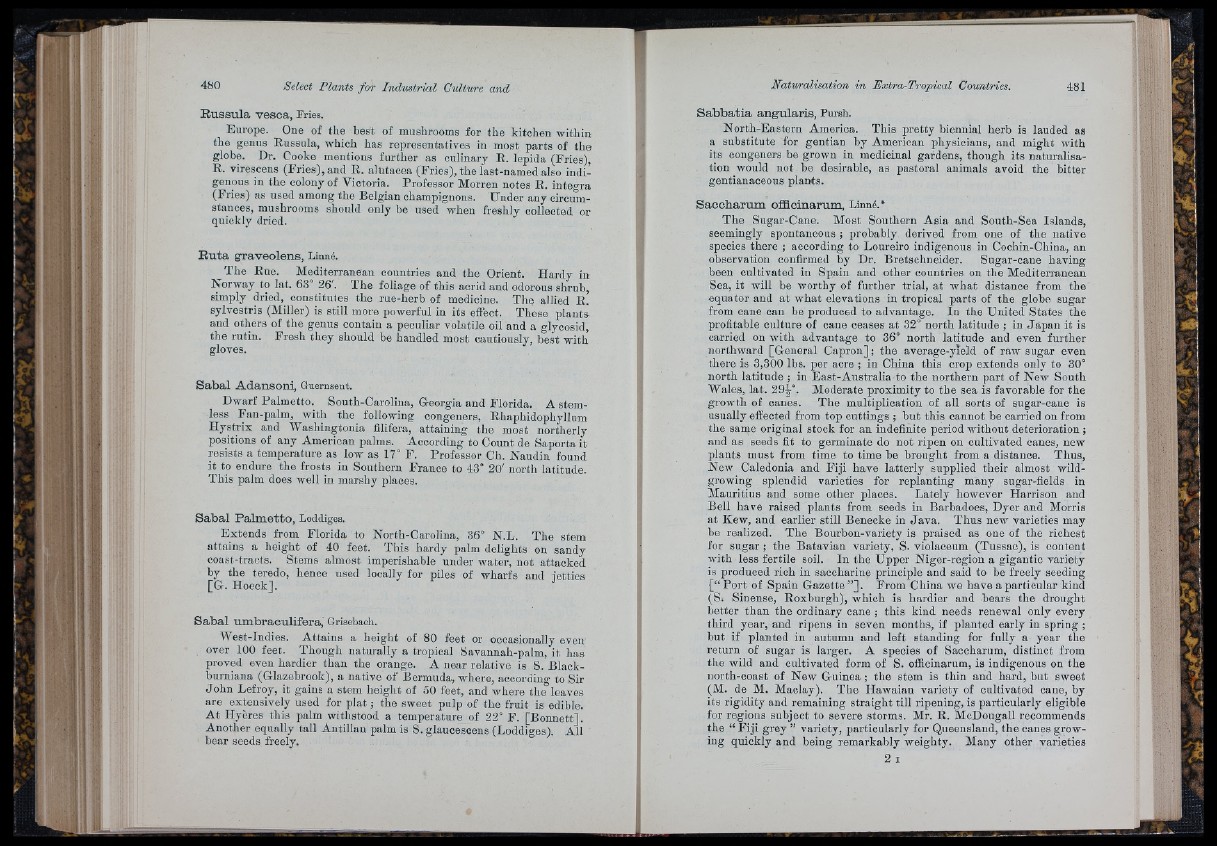
I
il
■>1! '.j
I '
Russula vesca, Fries.
Europe. One of the best of mushrooms for the kitchen within
the genus Russula, which has representatives in most parts of the
globe. Dr. Cooke mentions further as eulmary R. lepida (Fries),
R. virescens (Fries), and R. alntaoea (Fries), the last-named also indigenous
in the colony of Victoria. Professor Morren notes R. integra
(Fries) as used among the Belgian champignons, finder any circumstances,
mushrooms should only be used when freshly collected or
quickly dried.
Euta graveolens, Linné.
The Rue. Mediterranean countries and the Orient. Hardy in
Norway to lat. 63 26'. The foliage of this acrid and odorous shrub,
simply dried, constitutes the rue-herb of medicine. The allied R.
sylvestris (Miller) is still more powerful in its effect. These plants
and others of the genus contain a peculiar volatile oil and a glycosid,
the rutin. Fresh they should be handled most cautiously, best with
gloves.
Sataal Adansoni, Guernsent.
Dwarf Palmetto. South-Carolina, Georgia and Florida. A stem-
less Fan-palm, with the following congeners, Rhaphidophyllum
H y rtrix and Washingtonia filifera, attaining the most northerly
positions of any American palms. According to Count de Saporta it
resists a temperature as low as 17° P. Professor Ch. Naudin found
it to endure the frosts in Southern France to 43° 20' north latitude.
This palm does well in marshy places.
Sabal Palmetto, Loddiges.
Extends from Florida to North-Carolina, 36° N.L. The stem
attains a height of 40 feet. This hardy palm delights on sandy
coast-traots. Stems almost imperishable under water, not attacked
by the teredo, hence used locally for piles of wharfs and jetties
[G . Hoeck].
Sabal umbraculifera, Grisebach.
West-Indies. Attains a height of 80 feet or occasionally even
over 100 feet. Though naturally a tropical Savaunali-palm, it has
proved even hardier than the orange. A near relative is S. Blaok-
burniana (Glazebrook), a native of Bermuda, where, according to Sir
John Lefroy, it gains a stem height of 50 feet, and where the leaves
are extensively used for plat ; the sweet pulp of the fruit is edible.
A t Hyères this palm withstood a temperature of 22° F. [Bonuett].
Another equally tall Antillan palm is S. glauoeseens (Loddiges). All
bear seeds freely.
Naturalisation in Extra-Tropical Countries. 481
Sabbatia angularis, Pursh.
North-Eastern America. This pretty biennial herb is lauded as
a substitute for gentian by American physicians, and might with
its congeners be grown iu medicinal gardens, though its naturalisation
would not be desirable, as pastoral animals avoid the hitter
gentianaceous plants.
Saooharum offlcinarum, Linné.*
The Sugar-Cane. Most Southern Asia and South-Sea Islands,
seemingly spontaneous ; probably derived from one of the native
species there ; according to Loureiro indigenous in Cochin-China, an
observation confirmed by Dr. Bretschneider. Sugar-cane having
been cultivated in Spain and other countries on tlie Mediterranean
Sea, it will be worthy of further trial, a t what distance from the
equator and at what elevations in tropical parts of the globe sugar
from cane can he produced to advantage. In the United States the
profitable culture of cane ceases at 32° north latitude ; in Jap an it is
carried on with advantage to 36° north latitude and even further
northward [General Capron]; the average-yield of raw sugar even
there is 3,300 lbs. per acre ; in China this crop extends only to 30°
north latitude ; in East-Australia to the northern part of New South
Wales, lat. 294°- Moderate proximity to tbe sea is favorable for the
growth of canes. The multiplication of all sorts of sugar-cane is
usually effected from top cuttings ; bnt this cannot be carried ou from
the same original stock for an indefinite period w ithout deterioration ;
and as seeds fit to germinate do not ripen on cultivated canes, new
plants must from time to time he brought from a distance. Thus,
New Caledonia and Fiji have latterly supplied their almost wild-
growing splendid varieties for replanting many sugar-fields in
Mauritius and some other places. Lately however Harrison and
Bell have raised plants from seeds in Barbadoes, Dyer and Morris
at Kew, and earlier still Benecke in Jav a . Thus new varieties may
be realized. The Bourbon-variety is praised as one of the richest
for sugar ; the Batavian variety, S. violaoeum (Tussac), is content
with less fertile soil. In the Upper Niger-region a gigantic variety
is produced rich in saccharine principle and said to be freely seeding
[ “ Port of Spain Gazette” ] . From China we have a particular kind
(S. Sinense, Roxburgh), which is hardier and bears the drought
better than the ordinary cane ; this kind needs renewal only every
third year, and ripens iu seven months, if planted early in spring ;
but if planted in autumn and left standing for fully a year the
return of sugar is larger. A species of Saocharum, distinct from
the wild and cultivated form of S. oflfieinarutn, is indigenous on the
iiorth-coast of New Guinea; the stem is thin aud hard, but sweet
(M. de M. Maclay). The Hawaian variety of cultivated cane, by
its rigidity and remaining straight till ripening, is particularly eligible
for regions subject to severe storms. Mr. R. McDougall recommends
the “ Fiji grey ” variety, particularly for Queensland, the canes growing
quickly and being remarkably weighty. Many other varieties